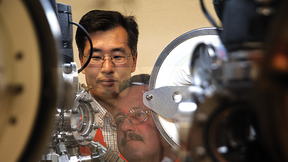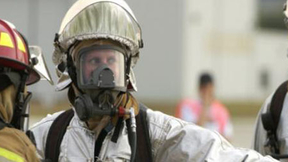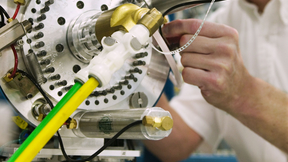Back
Physical and Life Sciences
Plutonium at 150 years
The article below presents a summary of ongoing work at Lawrence Livermore National Laboratory. The work is to assess how radioactive decay in plutonium affects its material properties as they relate to the performance of nuclear weapons. This work is a continuation of the joint plutonium aging study done by Los Alamos and Lawrence Livermore National laboratories. That…
X-ray laser takes aim at cosmic mystery
An international collaboration including researchers from Lawrence Livermore National Laboratory has refined a key process in understanding extreme plasmas such as those found in the sun, stars, at the rims of black holes and galaxy clusters. In short, the team identified a new solution to an astrophysical phenomenon through a series of laser experiments. In the new…
Science Express article describes new clues to planetary evolution
A new understanding of planetary evolution could emerge from studies of the behavior of magnesium oxide under high pressures and temperatures, such as those found in the interior of Earth and Earth-like planets. In an article recently published by Science Express , a team of UC Berkeley and LLNL researchers, led by former LLNL researcher Stewart McWilliams, now of the…
LLNL to work with Interior Department on underground coal gasification
LLNL's Underground Coal Gasification (UCG) Program has received a two-year research grant to study water-quality hazard mitigation strategies from the Office of Surface Mining Reclamation and Enforcement (OSMRE). OSMRE is a Department of the Interior bureau charged with ensuring the public and the environment are protected during and after coal mining operations. In recent…
A human-caused climate change signal emerges from the noise
LIVERMORE, Calif. -- By comparing simulations from 20 different computer models to satellite observations, Lawrence Livermore climate scientists and colleagues from 16 other organizations have found that tropospheric and stratospheric temperature changes are clearly related to human activities. See simulation (.mov) The team looked at geographical patterns of atmospheric…
NARAC to more quickly predict haz mat releases
The National Nuclear Security Administration (NNSA) on Monday announced that it recently sponsored the installation of a 336-processor computing cluster at the Lawrence Livermore National Laboratory (LLNL) National Atmospheric Release Advisory Center (NARAC). This new cluster allows consequences predictions for hazardous material releases to be completed approximately 50…
LLNL scientists assist in building detector to search for elusive dark matter material
Lawrence Livermore National Laboratory researchers are making key contributions to a physics experiment that will look for one of nature's most elusive particles, "dark matter," using a tank nearly a mile underground beneath the Black Hills of South Dakota. The Large Underground Xenon (LUX) experiment located at the Sanford Underground Research Facility in Lead, S.D. is…
Have you met LEXI?
LEXI is a new robot at work in the firing tanks of the Lab's High Explosives Applications Facility (HEAF) and the work that's done there for the National Explosives Engineering Sciences Security (NEXESS) Center. The tri-lab program is funded by the Department of Homeland Security to assess threats from explosives and to evaluate countermeasures. See the video . NEXESS was…
Ocean salinity trends show human fingerprint
Changes in ocean salinity over the second half of the 20th century are consistent with changes driven by human activities and are inconsistent with natural climate variations, according to a new study by Laboratory researchers. Observed salinity changes agree with what computer models have suggested would happen to salinity patterns in a warming world, said Scripps climate…
Milky Way's black hole getting ready for snack
Get ready for a fascinating eating experience in the center of our galaxy.The event involves a black hole that may devour much of an approaching cloud of dust and gas known as G2.A supercomputer simulation prepared by two Lab physicists and a former postdoc suggests that some of G2 will survive, although its surviving mass will be torn apart, leaving it with a different…
New military apparel repels chemical and biological agents
LIVERMORE, Calif. -- Lawrence Livermore National Laboratory scientists and collaborators are developing a new military uniform material that repels chemical and biological agents using a novel carbon nanotube fabric. The material will be designed to undergo a rapid transition from a breathable state to a protective state. The highly breathable membranes would have pores…
Dick Post receives Lifetime Achievement Award
One of the Laboratory's early phone books, in December 1952, listed about 250 employees, including a newly-transferred physicist named Dick Post. At the time, Harry Truman was the nation's president and Herb York was the director of Lawrence Livermore National Laboratory. Eleven presidents have come and gone, and 10 LLNL directors have come and gone, but Dick Post has…
Cold cases heat up through Lawrence Livermore approach to identifying remains
LIVERMORE, Calif. -- In an effort to identify the thousands of John/Jane Doe cold cases in the United States, a Lawrence Livermore National Laboratory researcher and a team of international collaborators have found a multidisciplinary approach to identifying the remains of missing persons. Using "bomb pulse" radiocarbon analysis developed at Lawrence Livermore, combined…
PLS names outstanding postdocs
What makes an outstanding postdoc? Ask members of the Physical and Life Sciences Directorate (PLS) who last month bequeathed the title on four individuals during an awards presentation by former Principal Associate Director Bill Goldstein.This award is given to postdocs with an exceptional level of accomplishment while working at LLNL. The 2012 PLS Outstanding Postdocs are…
Changing the dynamics of bulk materials
Lawrence Livermore researchers have developed a new bulk material whose physical properties can be dynamically changed by an external signal. The scientists came up with a method to fabricate mass-producible graphene-based bulk materials from low-cost polymer-derived carbon foams by selectively removing carbon atoms from a network composed of both unstructured carbon and…
Livermore experiments illuminate how order arises in the cosmos
LIVERMORE, Calif. -- One of the unsolved mysteries of contemporary science is how highly organized structures can emerge from the random motion of particles. This applies to many situations ranging from astrophysical objects that extend over millions of light years to the birth of life on Earth. The surprising discovery of self-organized electromagnetic fields in counter…
Paper explores new regimes in fast ignition
Nearly 20 years ago, a group of researchers at the Laboratory proposed a hole boring process that would serve as the original scheme for fast ignition. Today, LLNL researchers are pushing this research ahead into new regimes. When a laser beam is reflected from a mirror, a finite amount of momentum - carried by light - is transferred to the mirror so that the mirror is…
LLNL researchers receive nearly $2.75 million for high energy density projects
The Department of Energy's (DOE) National Nuclear Security Administration (NNSA) and Office of Science (SC) have awarded more than $14 million in research awards as part of the Joint Program in High Energy Density Laboratory Plasmas (HEDLP). Six LLNL researchers received nearly $2.75 million for their projects. "These awards demonstrate the strong and valuable partnership…
LLNL researchers authored five of top 10 cited papers in Physics of Plasmas
Five out of the top 10 Physics of Plasma (PoP) papers for all time have LLNL researchers as first authors and co-authors.This recognition by the scientific community is strongly indicative of LLNL's signature core competencies in plasma physics and high-energy-density science.The five LLNL-authored papers in the Physics of Plasmas' "top 10 list" are:J. Lindl, "Development…
100th shot for LLNL's 'gun in the desert'
Lawrence Livermore National Laboratory's JASPER gas gun has fired its 100th shot. JASPER (the Joint Actinide Shock Physics Experimental Research) is a key scientific tool for the National Nuclear Security Administration's Stockpile Stewardship Program (SSP). This program's combination of computer simulations, scientific theory and above-ground experiments has allowed the…

























